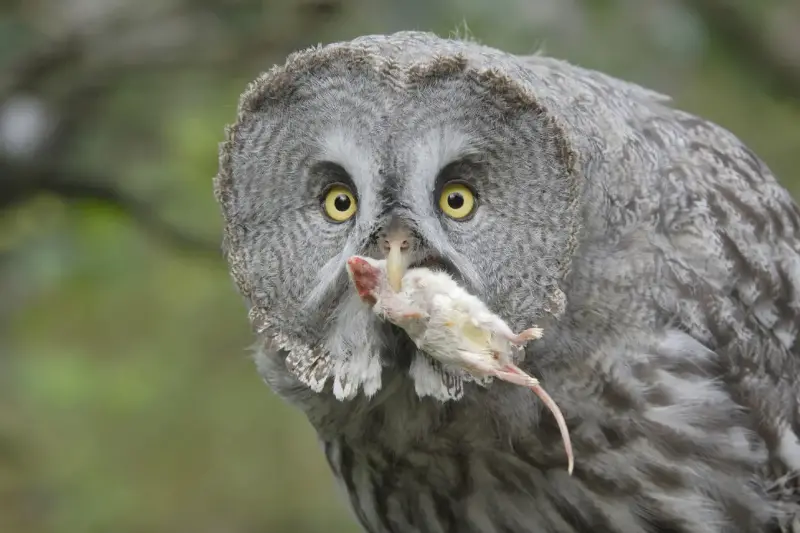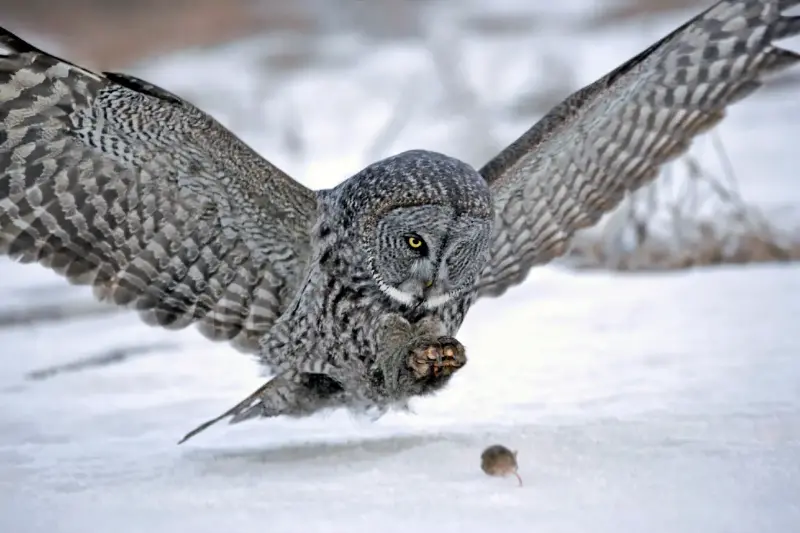
Amidst a snowy wilderness, where the silence is only broken by the whisper of the wind, a remarkable drama unfolds nightly. An owl, gliding silently above the frozen landscape, locks onto its prey—hidden beneath a thick blanket of snow. This is not just folklore; it’s a marvel of nature, rooted in cutting-edge science and centuries of fascination. Welcome to the mysterious world of the owl that can hear mice from 100 metres away—even when they’re tunnelling under snow. Prepare to have your perceptions of predator and prey forever altered.
The Science Behind Super-Sonic Hearing
In the fierce competition for survival, owls have developed one of the most extraordinary auditory systems in the animal kingdom. Specifically, the Great Grey Owl and its close relatives possess a face designed like a massive satellite dish—broad, flat, and framed with fluffy “facial discs.”
These discs don’t just give owls their signature look; they serve an essential function: channelling the faintest rustles directly to their ears. Unlike humans, whose ears are aligned symmetrically, owls sport asymmetrical ear openings—one set higher than the other. This off-kilter design gives them a kind of three-dimensional auditory map. When a mouse scurries beneath the snow, the slightest crunch is detected by one ear microseconds before the other. The brain, acting like a sophisticated GPS system, calculates the exact direction and distance to the hidden rodent.
A Predator’s Winter Toolkit
Winter transforms landscapes into survival arenas. Mice and voles retreat beneath snow to escape freezing winds—and likely, the eyes of predators. But for these specialised owls, the snow isn’t a barrier; it’s hardly even a challenge.
- Owls can detect prey sounds as soft as 5 decibels—a whisper amongst whispers.
- They use their acute hearing to “see” through snow, locating mice as deep as 60 centimetres below the surface.
- Studies have revealed Great Grey Owls making flawless plunges into unbroken snow, snatching unseen prey with pinpoint precision.
When the moment arrives, the owl remains utterly silent—a feat enabled by fringed feathers that muffle its wingbeats. With unerring accuracy, it dives, punching straight through the snow to seize its unsuspecting meal. For scientists observing these hunts, the technique is almost otherworldly: a harmonious ballet of stealth, speed, and sensory mastery.
Survival Secrets of the Snow Hunter
How do these owls manage such extraordinary feats? The answer lies in a combination of anatomy, adaptation, and evolution.
- Facial Ruffs: Special feathers around the face direct sound to the ears, like a living satellite.
- Ear Placement: Asymmetrical ears allow these predators to pinpoint prey with astonishing precision.
- Brainpower: The owl’s auditory cortex is developed to process time and intensity differences, much like our own advanced technology.
- Plunge Attack: The owl’s talons are long and strong, able to reach deep beneath snow to secure a grip on hidden quarry.
- Silent Approach: Specialised wing feathers reduce noise, so prey never hears the owl until it’s too late.
All these factors combine to create a hunter so finely tuned that not even a metre of snow can conceal a mouse’s trembling heartbeat.

Nature’s Living Radar: Beyond the Myths
Folk tales often speak of the all-seeing, all-knowing owl—a symbol of wisdom and mystery. Science gives us an even more impressive story. It turns out that the owl’s deadliest weapon is not its talons or night vision, but an auditory prowess that rivals technology.
This ability has inspired everything from better hearing aids to advanced military sensors. Nature, it seems, is often the original inventor, with millions of years at its drawing board.
Whether you’re trudging across a snowy field or gazing at wooded shadows tinged with moonlight, imagine the invisible battles waged beneath. In the quiet, a whisper travels—a signal caught by an aerial predator. The lesson? Even the unseen and unheard play their part in the theatre of life and death, every night, on fields both near and far.
So next time you hear the haunting call of an owl on a winter’s night, consider the hidden world it rules—a realm measured not in what you see, but in what you cannot hear. What other secrets, hidden by nature’s vast and silent snows, remain to be discovered?
